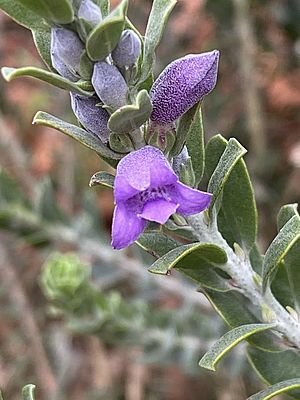Resinous eremophila facts for kids
Quick facts for kids Resinous eremophila |
|
|---|---|
 |
|
| In Mount Annana Botanic Garden | |
| Conservation status | |
| Scientific classification | |
| Genus: |
Eremophila (plant)
|
| Species: |
resinosa
|
| Synonyms | |
|
|
The Resinous Eremophila (scientific name: Eremophila resinosa) is a beautiful flowering plant. It belongs to the figwort family, called Scrophulariaceae. This special plant grows only in Western Australia. It's a shrub that spreads out, with young leaves that feel sticky. It has short leaves, small sepals, and flowers that can be mauve, purple, or sometimes white.
Contents
What the Resinous Eremophila Looks Like
The Resinous Eremophila is a spreading shrub. It usually grows between 0.4 and 1.0 m (1 and 3 ft) tall. It can also spread out to about 1.0 m (3 ft) wide. Its branches have tiny, raised, amber-colored bumps. These bumps are clear, like glass. The branches are also covered in fine, branched hairs.
Leaves and Flowers
The leaves of this plant are shaped like a spear or an egg. The narrower part is at the bottom. They are 6–17 mm (0.2–0.7 in) long and about 2 mm (0.08 in) wide. These leaves also have fine, branched hairs.
The flowers grow one by one where the leaves meet the stem. Each flower sits on a very short stalk, only about 1 mm (0.04 in) long. There are five green, pointed sepals that protect the flower bud. These sepals are 3–5.5 mm (0.1–0.2 in) long.
The petals are 13–18 mm (0.5–0.7 in) long. They join together at the bottom to form a tube shape. The flowers can be mauve, purple, or sometimes white. If they are colored, the outside looks lighter because of the fine hairs covering them. The inside of the flower tube often has spots. The tips of the petals are smooth, but the inside of the tube is full of long hairs. The four stamens (the parts that make pollen) are hidden inside the petal tube.
Flowering and Fruits
This plant flowers from May to September. After the flowers, it produces dry, oval-shaped fruits. These fruits have a pointed end and feel a bit rough. They are about 4 mm (0.2 in) long.
How the Plant Got Its Name
The Resinous Eremophila was first officially described in 1838. A scientist named Stephan Endlicher gave it the name Pholidia resinosa. This description was published in a book called Stirpium Australasicarum Herbarii Hugeliani Decades Tres.
Later, in 1860, another scientist named Ferdinand von Mueller changed its name. He renamed it Eremophila resinosa. This change was published in Papers and Proceedings of the Royal Society of Van Diemen's Land. The word resinosa comes from Latin. It means "full of resin" or "gummy," which describes the plant's sticky feel.
Where the Resinous Eremophila Grows
The Resinous Eremophila grows in the wheatbelt area of Western Australia. This is north-east of a town called Merredin. It likes to grow in different types of soil. You can find it in clay, gravelly, and sandy soils.
Protecting This Special Plant
The Resinous Eremophila is considered an "Endangered" plant. This means it is at high risk of disappearing from the wild. It is protected under a law called the Environment Protection and Biodiversity Conservation Act 1999 (EPBC Act).
In April 2008, scientists knew of only 26 natural groups of these plants. There were about 1,418 individual plants in total. To help save the species, scientists started growing new plants.
Conservation Efforts
In 2004, five copies of the plant were grown using a special method called tissue culture. These plants were then planted in Westonia. Seeds were also collected and grown at the same place.
Many of these new plants survived well. Both the tissue-cultured plants and those grown from seeds did great. Today, more than 4,000 Resinous Eremophila plants are growing. Also, about 2 million of its fruits are stored safely for a long time. This helps make sure the plant can be grown in the future.
Growing Resinous Eremophila in Gardens
This small shrub can be a great addition to a garden. It produces many purple flowers in spring. It is also a very tough plant, which makes it good for small gardens.
It is easy to grow new plants from cuttings (small pieces of the plant). It can grow in many different types of soil, even clay. It likes full sun or partial shade. This plant is very good at handling dry conditions. It needs little or no watering, even during long droughts. It can also survive very cold frosts.


